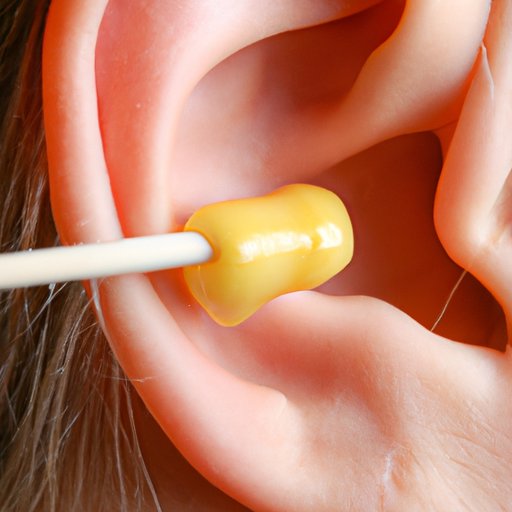
I. Introduction
Earwax buildup is a common problem that affects almost everyone at some point in their lives. Ear wax, medically known as cerumen, is a natural substance produced by the ear to protect against dust, dirt, and bacteria. However, an accumulation of earwax can lead to discomfort, hearing problems, and in rare cases, even infection. Therefore, it is important to address earwax buildup properly to avoid any potential problems.
II. A Complete Guide to Removing Ear Wax Safely and Effectively
The anatomy of the ear is complex, and there are different methods for removing ear wax. Some of the most common methods include earwax removal kits, irrigation, and microsuction. Earwax removal kits are available over-the-counter and typically include an oil-based solution to soften the earwax, and a tool to scoop out the wax. Irrigation involves flushing the ear with water to dislodge earwax, while microsuction is a technique in which a healthcare professional uses a tiny vacuum-like device to remove the earwax. Each method has its advantages and disadvantages, and it’s important to choose the most appropriate method based on the individual’s age, medical history, and severity of the earwax buildup. Safety precautions when removing ear wax include avoiding inserting anything into the ear canal smaller than your elbow, and seeking medical attention if you experience severe pain or bleeding.
III. 10 Simple Home Remedies to Get Rid of Ear Wax Naturally
Natural remedies can be an effective and cost-effective way to remove ear wax. Some of the most popular natural remedies include saline solution, hydrogen peroxide, olive oil, baking soda, and garlic oil. Saline solution involves mixing salt and water to create a solution that can help soften earwax. Hydrogen peroxide is a mild antiseptic that can help dislodge ear wax, while olive oil can help lubricate the ear canal and make it easier to remove wax. Baking soda can also be mixed with water to create a solution for earwax removal, while garlic oil has natural antibacterial properties and can help ease pain and inflammation. Proper instructions on how to use these remedies are crucial in achieving the expected results.
IV. The Do’s and Don’ts of Removing Ear Wax: Tips and Tricks
When it comes to removing ear wax, there are certain do’s and don’ts that everyone should be aware of. One of the most important things to remember is to avoid inserting anything smaller than your elbow in your ear canal, as you risk damaging your ear and causing infection. Another important tip is to avoid using ear candles as they can lead to burns and even hearing loss. Some recommended tips for safely and effectively removing earwax include using warm water to irrigate the ear, using hydrogen peroxide to dissolve wax, and using a soft cloth or tissue to gently clean the outer ear. If you experience severe pain, hearing loss, or bleeding, you should seek medical attention immediately.
V. From Q-tips to Ear Drops: The Best Products for Removing Ear Wax
Many products are available in the market for ear wax removal. Some of the most popular products include cotton swabs, ear drops, earwax candles, and earwax removal tools. However, each product has its pros and cons, and it’s important to choose the most appropriate one based on your individual needs. Cotton swabs, for example, are not recommended for ear cleaning as they can push the earwax further into the ear canal. Ear drops, on the other hand, can help dissolve earwax and ease discomfort. Earwax candles have been controversial and many experts do not recommend them. Earwax removal tools include a variety of devices that are designed to scoop out ear wax. Like with any method, safety precautions should be taken when using these products.
VI. Why You Shouldn’t Ignore Ear Wax Buildup: How to Clean Your Ears Like a Pro
Ignoring ear wax buildup can lead to serious consequences including hearing loss, infection, and tinnitus. It is important to clean your ears regularly to avoid these problems. Tips for cleaning your ears like a pro include using warm water to irrigate the ear, using a soft cloth or tissue to clean the outer ear, and avoiding swabs that may push earwax further into the ear canal. Investing in regular checkups with an ear professional can help ensure that your ears are healthy and clean.
VII. Conclusion
Proper ear wax management is crucial for maintaining good ear health. In addition to the methods discussed in this guide, there are also other natural and medical options available. It is important to choose the most appropriate method for your individual needs and to take appropriate steps to ensure your safety and health. Don’t ignore ear wax buildup, and take action to maintain good ear hygiene.




